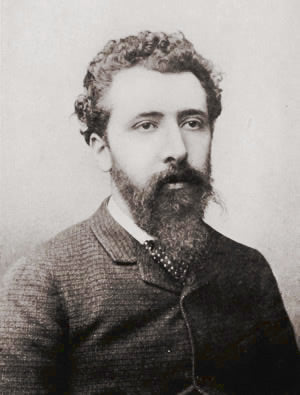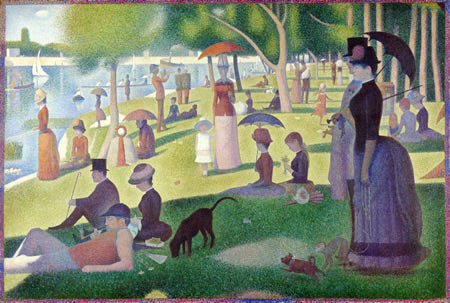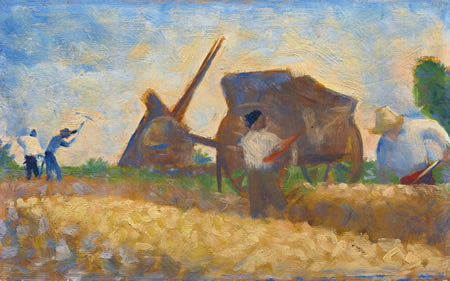Georges Pierre Seurat

| Birth Name: | Georges Pierre Seurat |
|---|---|
| Artistic Name: | Seurat. |
| Nationality: | France |
| Year of Birth: | 1859, Paris. |
| Year of Death: | 1891, Paris. |
| Styles: | Post-Impressionism, Pointillism, Modern Art |
He is one of the founders of Post-Impressionism, inventor of pointillism and a forerunner of modern color printing techniques. His most outstanding works were created by painting thousands of dots of pure colors, which according to their distribution form different colors and figures on the viewer's retina.
Seurat's Paintings
His style shows the neoclassical influence of his school, evident in the often sculptural and stone-like appearance of his characters. His canvases are easily identifiable at first glance, in most cases, he not only created a technique, but also a new aesthetic.
-

"A Sunday Afternoon on the Island of La Grande Jatte"Author: SeuratStyle: PointillismOriginal Title: Un dimanche après-midi à l'Ile de la Grande JatteTitle (English): A Sunday Afternoon on the Island of La Grande JatteType: PaintingTechnique: OilSupport: CanvasYear: circa 1884Located at: Art Institute of Chicago.The most famous pointillist work of the artist. It depicts a summer landscape near Asnieres in Paris. A place frequented by the working classes, who could not afford to travel to more luxurious coastlines.
Painted dot by dot, it is considered the purest exponent of French pointillism. It is imbued with Seurat's most distinctive characteristics, such as: combination of vibrant colors and a great amount of cool light.
-

"Bathers at Asnières"Author: SeuratStyle: PointillismOriginal Title: Une baignade à AsnièresTitle (English): Bathers at AsnièresType: PaintingTechnique: OilSupport: CanvasYear: 1884Located at: The National Gallery, LondonLike the previous work, it presents a luminous landscape, in the same environment and executed with the same pointillist technique.
Although today it is considered a key piece of Impressionism, its somewhat Naïve appearance led to it not being accepted by the critics of the time. Rejected for exhibition in one of the main galleries of the time: The Paris Salon.
-

"The Channel of Gravelines, Petit Fort Philippe"Author: SeuratStyle: PointillistTitle (English): The Channel of Gravelines, Petit Fort PhilippeType: PaintingTechnique: OilSupport: CanvasYear: 1890Located at: Indianapolis Museum of ArtPainted in the later period of the artist's life. It demonstrates an aesthetic turn full of freshness, towards a new emerging style, of which he is considered one of its founders: Post-Impressionism.
-

"The Circus"Author: SeuratStyle: PointillismGenre: Genre paintingOriginal Title: CirqueTitle (English): The CircusType: PaintingTechnique: OilSupport: CanvasYear: 1891Located at: Musée d'Orsay, ParisJoy is one of the moods that the artist perpetually transmits, through color and motifs. In this work, he takes it to its maximum power: clear, vibrant colors and figures that seem to smile.
The dynamism of the composition is remarkable, the stage part spins like a whirlwind in contrast to the stillness of the stands and the audience.
-

"The Lighthouse at Honfleur"Author: SeuratStyle: Pointillism, ModernismTitle (English): The Lighthouse at HonfleurType: PaintingTechnique: OilSupport: CanvasCanvas Size: 66.7 x 81.9 cmYear: 1886Located at: National Gallery of Art, Washington.The artist confirms his technical proposal of chromatic construction through dots, this work and others like it earned him the "title" of inventor of Pointillism and Divisionism, consisting of offering different colors, through small dots of primary colors, without mixing. A technique similar to that which is now more than widespread, in the printing of large-format graphics using dots: yellow, cyan blue, and magenta.
-

"The Models"Author: SeuratStyle: Post-ImpressionismOriginal Title: Les PoseusesTitle (English): The ModelsType: PaintingTechnique: OilSupport: CanvasCanvas Size: 200 x 249.9 cmYear: circa 1885Located at: Barnes Foundation, Philadelphia, USA.This is one of the warmest motifs created by the artist, who rarely depicted human anatomies in such detail, especially nudes. One of the motivations for this painting was to demonstrate to critics that the pointillism technique was capable of creating figures with "soul," as he had been labeled a cold and overly static painter.
Behind the model, one can see Seurat's own work:
"A Sunday Afternoon on the Island of La Grande Jatte". -

"The Laborers"Author: SeuratStyle: ImpressionismTitle (English): The LaborersType: PaintingTechnique: OilSupport: CanvasYear: 1883Located at: National Gallery of Art, Washington, USA.A lesser-known work, but no less important in the painter's catalog, as it is one of the best examples of his technique with thick brushstrokes, much closer to traditional Impressionism. Yet, it features an extraordinary richness of color, vibrant contrasts, and very vivid nuances.
-

"Young Woman Powdering Herself"Author: SeuratStyle: Modern PointillismOriginal Title: Jeune femme se poudrantTitle (English): Young Woman Powdering HerselfType: PaintingTechnique: OilSupport: CanvasCanvas Size: 95.5 x 79.5 cmYear: 1890Located at: Courtauld Gallery, London.The model in this portrait is Miss Madeleine Knobloch, who was romantically involved with the Painter himself. The figures and shapes exude voluptuousness, joy, and madness; they reveal the artist's infatuation, with a ridiculously small table and window, vibrant and playful colors. The main character's figure has an imposing, fun, and very feminine halo.
-

"Seascape at Port-en-Bessin, Normandy"Author: SeuratStyle: PointillismTitle (English): Seascape at Port-en-Bessin, NormandyType: PaintingTechnique: OilSupport: CanvasCanvas Size: 65.1 x 80.9 cmYear: 1888Located at: National Gallery of Art, Washington, USA.Seascape of the French coast, west of Paris. It shows a green cliff, a warm sky, and the sea in the background with a small lighthouse.
-

"Port-en-Bessin, Entrance to the Harbor"Author: SeuratStyle: Post-ImpressionismTitle (English): Port-en-Bessin, Entrance to the HarborType: PaintingTechnique: OilSupport: CanvasYear: 1888Located at: MoMA Museum, New York.Landscape of the Normandy beach, showing a piece of coast with sand and grass, emerging from below and occupying almost half of the painting, above it is shallow, clear water with dark spots; 2 sailboats inside the dock, 5 in the mid-distance, and at least 12 on the high seas.
Bright colors and a very calm character; both characteristics typical of the works Seurat painted on his coastal trips.
-

"The Eiffel Tower"Author: SeuratStyle: PointillismOriginal Title: La Tour EiffelTitle (English): The Eiffel TowerType: PaintingTechnique: OilSupport: CanvasCanvas Size: 24.1 cm x 15.2 cmYear: circa 1889Located at: San Francisco Museum of Fine Arts, USA.A small-scale work of the Eiffel Tower nearing completion, reflecting the artist's admiration for the magnificent metallic monument. Unlike more purist Impressionists, many of whom rejected the new architectural aesthetics.
-

"View of Fort Samson"Author: SeuratStyle: Post-ImpressionismGenre: LandscapeTitle (English): View of Fort SamsonType: PaintingTechnique: OilSupport: CanvasCanvas Size: 65 x 81.5 cmYear: 1885Located at: Hermitage Museum, Saint Petersburg.A location accessible only on foot, in the French commune of Grandcamp-Maisy, where the artist spent his holidays that year
It depicts a raw and rural environment, dry ground, and fresh air. The cool and warm tones contrast, creating a sunny and refreshing atmosphere.
Order it in the custom oil paintings section
Related famous painters:
↑Back to top